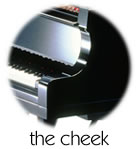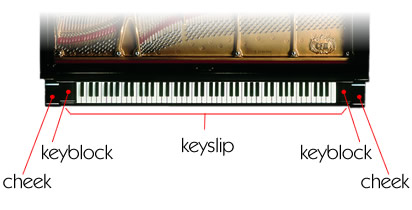
The Cheek, Keyblock & Keyslip
The Cheek
There are two cheeks on the piano - one on each end of the keyboard. The cheeks are connected to the rim - one at the end of the spine on the bass side, and one at the end of the bentside on the treble side. The keyboard sits between the cheeks, and is held in position by the keyblocks.

The Keyblock
The keyblock, also called the cheekblock, is the removable block of wood found on each end of the keyboard. These blocks hold the keyboard in place and keep it from shifting. The keyblocks are stained to match the finish of the case.
The Keyslip
The keyslip is the long removable strip of wood that runs the full front width of the piano. The keyslip is found just under the keys, and is designed to cover the keyframe. The keyslip is also stained to match the finish of the case.
